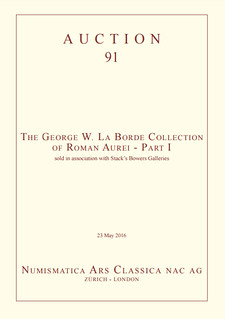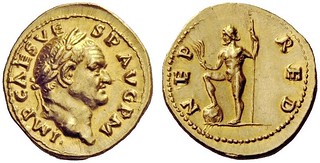
PREV ARTICLE
NEXT ARTICLE
FULL ISSUE
PREV FULL ISSUE
THE GEORGE W. LA BORDE COLLECTION OF ROMAN AUREI
E-Sylum subscriber Hadrien J. Rambach was welcoming host when I visited London several years ago. For many years he has been a
consultant to George W. La Borde in the acquisition of his important collection of Roman Aurei. Part 1 of the collection will be sold May
23, 2016 by Ars Classica in association with Stack's Bowers Galleries. With permission, here is Hadrien's introduction to the
sale. -Editor
George named his oil-exploration company Athena Resources Ltd., with a Greek coin in mind. He understood that ancient coins and engraved gems allowed him to possess antiquities in the rarest and finest condition, illustrating the lives and the monuments of the ancients. And they are neither fragile nor space consuming, which is certainly a matter to consider when a collector acquires hundreds of artefacts. My role of advisor was notably to help George avoid mistakes when he started to collect, and to invest very significant sums of money in a market of which he did not necessarily know all the rules. A wise businessman, he knew that an advisor could help him reach the pinnacle of collecting, and be as successful at this as he had been in his own field. Nevertheless, of course, I had to understand and respect his taste and interests, which is why – for example – some emperors are represented more often than others, and why there is a good series of reverses with Hercules.
I often recommended against buying a coin, when I knew that a nicer example could be found in the future, or if I was aware of potential issues (condition or provenance). Also, I was occasionally able to add useful comments on the rarity or importance of a coin, and such was the case with an aureus of Faustina Minor, sold in the Gemini auction of 2006, which will be sold in the second part of the collection: though it had no provenance indicated on the catalogue, I was able to inform George that it came from the collection of Don Manuel Vidal Quadras Y Ramón (1818-1894), which the Paris dealer Etienne Bourgey sold at auction in December 1913. I was also able to help George to decide the amount at which to bid, based on inside knowledge of who the seller is, and whether competitor-collectors intended to bid or not. I was hired to protect not only George’s interests, by helping him build the best collection possible considering both his means and the material available, but also for future generations – by trying to build a group that will be as valuable as possible when the time comes to resell it. Some coins, for one reason or another, may be overpriced. Other coins, although nice, could be found in better condition. Coins that do not attract the eye may be worth acquiring for their rarity. Paying attention to the provenances, doing historical and comparative research, being informed early of upcoming auctions as well as collections available by private treaty, are all elements of what I, as an advisor, offered to George, and they are time-consuming, contact based, and require travelling, all of which freed up the time of an active businessman such as George and allowed him to focus on his work.
This does not mean that a coin without known provenance should be completely discounted, but its price should reflect the lack of established history. In fact, too few focus enough on the fact that « no provenance » means « no known provenance », and not necessarily that there is anything problematic about the piece. Take the aureus of Pertinax with Providence on the reverse: this coin is rare but far from unique, with some 125 recorded specimens; therefore, it is impossible to identify an example in an old catalogue unless it was reproduced. In addition, a good provenance adds value to an item: if it were not for its provenance, why would Jackie Kennedy-Onassis’ simulated pearl necklace have sold for over 200’000 dollars? George favoured the view that his advisor should be independent. While acting for George, I was privileged to have the freedom to look only for the best coins. Though coins were issued as multiples, and are on the whole rather common, many of them are very rare and “not everyone can own rarities”. Having money is not sufficient: a collector must also have patience and luck. George also had to be aware when an opportunity arose, and make sure not to miss his chance – and this is where an advisor offers valuable guidance. The 20th and 21st centuries have seen on offer major collections, such as those of Leo Biaggi, Charles Gillet, Athos Moretti and Claude Vaudecrane. I am proud to have helped to form George La Borde’s collection of Roman aurei – which I hope you will appreciate too.
Hadrien wrote an extensive 13-page Provenance Glossary at the end of the catalog with biographies and notes on the major collectors,
dealers, hoards and institutions which have previously held coins in the collection. This will be a valuable reference for collectors and
researchers. -Editor
Hadrien adds: Because the collection is so nice, NAC, Stack's Bowers and I thought it deserved a special catalogue - with especially lengthy historical notes for most coins, with clear provenances (collectors' full names and life-dates), and with biographies of the main collectors in the end, so that it can become a reference-catalogue such as those great ones of the past (Ponton d'Amécourt, Montagu, Ryan, Platt-Hall, Perfectionist, etc.). Of course I will be at the sale, offering my services to whoever wishes to bid but cannot do it in person. To visit the Ars Classica web site, see:
To download the complete auction catalog, see:

Wayne Homren, Editor The Numismatic Bibliomania Society is a non-profit organization promoting numismatic literature. See our web site at coinbooks.org. To submit items for publication in The E-Sylum, write to the Editor at this address: whomren@gmail.com To subscribe go to: https://my.binhost.com/lists/listinfo/esylum All Rights Reserved. NBS Home Page Contact the NBS webmaster 
|


